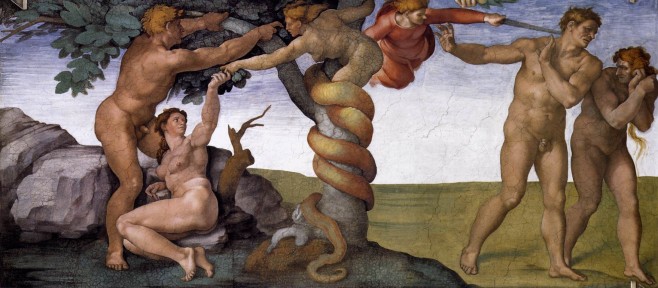Through the Gate of Septuagesima
Thou Shalt Surely Die of Death
The image — it is by Michelangelo and is found in the Sistine Chapel of the Vatican — depicts that most sorrowful mystery of Septuagesima Sunday: our first parents cast out of paradise. It is the visual complement to the sobering Magnificat Antiphon at First Vespers: “The Lord said unto Adam, Of the tree which is in the midst of paradise thou shalt not eat, for in the day that thou eatest thereof, thou shalt surely die of death.”
Toward the Cross and the Pierced Side
Chased out of paradise by the angel wielding a flaming sword, a naked Adam and Eve make their way toward death, toward the very death that the New Adam, naked upon the tree of the Cross will undo. There, on Calvary, the Cherub’s flaming sword will be replaced by the centurion’s lance, and the gate of paradise will be opened in the Saviour’s sacred side. Michelangelo’s magnificent crucifix in the sacristy of the Church of Santo Spirito in Florence illustrates the mystery towards which points the Cherub’s flaming sword.
The Pre-Lenten Season of the Church
Influenced, no doubt, by the practice of Greek Christians living in Rome and observing the Eastern preparation for Great Lent, Pope Saint Gregory the Great instituted the season of Septuagesima: three weeks of preparation for the Great Fast marked by solemn stations at the patriarchal basilicas of Saint Lawrence, Saint Paul, and Saint Peter. In this way the Roman Church prepared her Lenten observance under the auspices of the Eternal City’s glorious patrons. Dame Aemiliana Löhr, O.S.B. reflects on Septuagesima as the beginning of our passage through death into life:
A Beginning
More clearly than the First Sunday of Advent, Septuagesima forms a point of division. Not unreasonably, it has been questioned from time to time whether one ought to look here for the real beginning of the liturgical year. Today’s liturgy differs sharply from the Sundays just past. Contrasted with the joyous liturgy of Epiphany with its shining glance towards the fulfilment of Easter, Septuagesima seems almost gloomy. In every respect it carries the mark of a beginning, and that in the sense of of a laborious, sorrowful one, the character of every earthly as opposed to divine beginning. It is as if the Church had suddenly dropped down from the bright and festive upper storey of her house into the darkness of a low, vaulted crypt, into the earth’s womb, the tombs; prepared, now that she has celebrated the glorious feast of life at Epiphany, to seek out the dark and difficult beginnings of that life.
Farewell to the Alleluia
With a last cry of joy, which both gives a final occasion for the glory of Epiphany to shine amd anticipates the joy of Easter, the Church leaves behind her at the First Vespers of Sunday that song of heavenly joy, the alleluia.
Between Epiphany and Pascha
The Christmas and Epiphany season taught us again and again that it is not only God’s appearance in this world, but also, and most important, his saving work in and upon it which the Church wills to see present in her ritual; only in prospect of Easter does the feast of the Epiphany become for her fully a mystery. Her whole liturgy, as we shall soon see, turns about Easter, and the feast of Epiphany is only a prelude, or one might have it, a short play . . . which takes its meaning from the vision of salvation and glory completed. It does not exclude the way to salvation, but, so to speak, reduces it to a single point.
Pascha and Transitus
Easter contains both aspects: in an extended prelude it follows the whole way, and in the equally rich solemnity of a single night it rejoices in the glory it has won. The decisive point lies between the two: neither preparation nor celebration, but passage, pascha, in the sense of the typical pascha of the Old Testament which the Fathers translate with the word transitus: the passage out of the land of slavery to sin and living death, into God’s Canaan, the promised land of freedom in grace and of life for God’s children.
A True Beginning of Salvation
The annual return of Septuagesima Sunday is not merely an occasion for worship — and this is true of the whole liturgy — but a true beginning of salvation, which can only be brought to its completion by the common act of God and man; it is a moment as serious as ever can arise for man’s moral consciousness: decision for the Pasch of Christ, for the mystical death with Him in liturgy, which can only be carried out through the daily and hourly death of man, through turning away from sin and passing up to God. Today is the beginning of salvation, and the decision to seek salvation.
A Serious Joy
We have nothing to fear: the serious of this road [to salvation] is joined to a high joy, and to the certainty that death’s course ends in life. This joy, as well, is woven into the liturgy of the weeks to come, and it us under this double motif of seriousness and joy that the Church leads us through the gate of Septuagesima on to Christ’s road of death.
(Dame Aemiliana Löhr, O.S.B., The Mass Through the Year)

